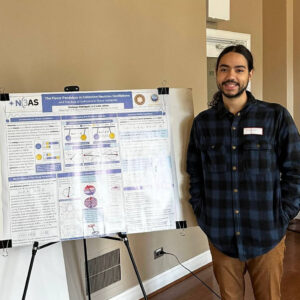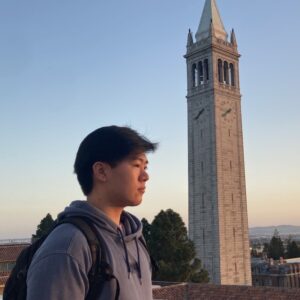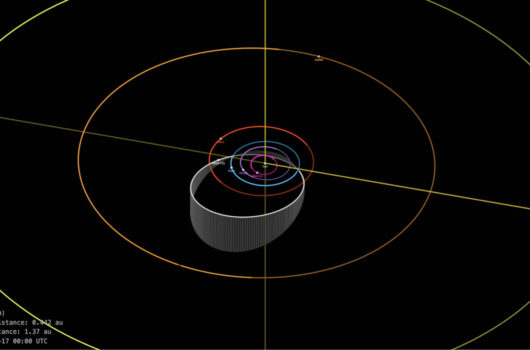Berkeley Undergraduate Researchers
Students in the N3AS undergraduate research program are supported directly by N3AS. In addition to a scientific mentor, the students have a non-science mentor and participate in bi-weekly lectures or activities with N3AS members. Learn more about the program.
You will also find recent scientific poster presentations by undergraduates below.
Jump to recent presentationsMeet recent participants

Catherine Welch, current INT UW/N3AS student
Publication on arXiv.org
by Mia Kumamoto and Catherine Welch:
Effects of Landau quantization on neutrino emission and absorption →
Some neutron stars known as magnetars possess very strong magnetic fields, with surface fields as large as ![]() and internal fields that are possibly stronger. Recent observations of the radio pulsar GLEAM-X J1627 suggest it may have a surface field as strong as
and internal fields that are possibly stronger. Recent observations of the radio pulsar GLEAM-X J1627 suggest it may have a surface field as strong as ![]() . In the presence of a strong magnetic field, the energy levels of electrons and protons are quantized and the Direct Urca process allows neutron stars to cool rapidly, even at low density. For the case of magnetic fields
. In the presence of a strong magnetic field, the energy levels of electrons and protons are quantized and the Direct Urca process allows neutron stars to cool rapidly, even at low density. For the case of magnetic fields ![]() , we find features in the emissivity due to energy quantization that are not captured by the frequently employed quasiclassical approximation… read more
, we find features in the emissivity due to energy quantization that are not captured by the frequently employed quasiclassical approximation… read more
Danial Baradaran, current N3AS student
Publication accepted by Physical Review D
by Danial Baradaran, Boryana Hadzhiyska, Martin J. White, and Noah Sailer:
Predicting the 21 cm field with a Hybrid Effective Field Theory approach →
A detection of the 21 cm signal can provide a unique window of opportunity for uncovering complex astrophysical phenomena at the epoch of reionization and placing constraints on cosmology at high redshifts, which are usually elusive to large-scale structure surveys. In this work, we provide a theoretical model based on a quadratic bias expansion capable of recovering the 21 cm power spectrum with high accuracy sufficient for upcoming ground-based radio interferometer experiments. In particular, we develop a hybrid effective field theory (HEFT) model in redshift space that leverages the accuracy of N-body simulations with the predictive power of analytical bias expansion models, and test it against the Thesan suite of radiative transfer hydrodynamical simulations… read more

Danial Baradaran


Santiago Rodriguez, Former student;
REU Coordinator, Space Sciences Laboratory
Publication on arXiv.org
by Lucas Johns and Santiago Rodriguez:
Collisional flavor pendula and neutrino quantum thermodynamics →
Neutrino flavor oscillation occurs because neutrinos emitted in a certain flavor are composed of a superposition of different neutrino mass states. In a dense enough environment, neutrino self-interactions synchronize flavor on large scales. In the two-flavor approximation, the resulting dynamics show similar behavior to the classical spinning top and inverted pendulum under some conditions. We explore the neutrino flavor pendulum with the addition of charged-current interactions and absorption/emission processes. In addition, investigating their effects in densities and time scales relevant to the isotropic and monochromatic emission of neutrinos from core-collapse supernovae, similar to neutrino the bulb model. We are able to identify the synchronized and bipolar modes of oscillation and constrain the polarization pendulum to a sphere and a circle in flavor space.
In 2023, Santiago has presented this research at the American Physical Society Far West Section, in San Diego.
Malika Golshan, Former student;
SULI intern at LBL
Publication on arXiv.org
by Malika Golshian and Adrian Bayer:
Massive νs through the CNN lens: interpreting the field-level neutrino mass information in weak lensing →
Neutrinos, once thought to be massless according to the standard model, have proven otherwise due to the fascinating observation of neutrino flavor oscillations. In our research project, we take a unique approach by harnessing the power of machine learning to address a crucial question: Can computers aid in distinguishing between mass-bearing and massless neutrinos? By leveraging Convolutional Neural Networks (CNNs) on simulated weak lensing maps, our goal is to achieve a more accurate measurement of neutrino mass using cosmological methods.
I am deeply grateful to both my mentors. Vanessa, my initial mentor, provided me with a solid foundation and inspiration for this project. Adrian then became my mentor while transitioning to his postdoctoral position at Princeton. His unwavering dedication and expertise guided me through the intricacies of data analysis.

Malika Golshan

Henry Purcell
Henry Purcell, Former student;
Intern, NASA Ames Research Center
Publication accepted by Physical Review D (May 2024)
by Henry Purcell, Sherwood Richers, Amol V. Patwardhan, Francois Foucart:
Three-flavor, Full Momentum Space Neutrino Spin Oscillations in Neutron Star Mergers →
In the presence of anisotropic neutrino and antineutrino fluxes, the quantum kinetic equations drive coherent oscillations in neutrino helicity, frequently referred to as spin oscillations. These oscillations depend directly on the absolute mass scale and Majorana phase, but are usually too transient to produce important effects. In this paper we present a full momentum-space analysis of Majorana neutrino spin oscillations in a snapshot of a three-dimensional neutron star merger simulation. We find an interesting angular dependence that allows for that resonant and adiabatic oscillations to occur along specific directions in a large volume of the merger remnant… read more

Daniel Xing
Graduated 2023, currently training in Los Alamos, working with the DUNE team
Discovering the origin of neutrino’s mass and their oscillation parameters could answer the matter antimatter asymmetry in our universe, and allow us to better understand astrophysics phenomena. Currently, multiple flagship experiments exploring neutrinos are underway, and to have full confidence in their results, accurate and precise neutrino nucleus cross sections are required. My project is to analyze data from lattice QCD calculations to determine one of these cross sections.
Current Students
| Student | Research Mentor | Career Mentor |
|---|---|---|
| Garrett Andre | Anupam Ray | Aviral Prakash |
| Danial Baradaran | Boryana Hadzhiyska | Evan Grohs |
| Yara Bawazir | Luca Boccioli | Alex Kim |
| Jenny Campbell | TBD | Evan Rule |
| Sebastian Gonzalez | Tetyana Pitik | Felipe Ortega Gama |
| Leonard Harkins | Felipe Ortega Gama | Noah Bliss |
| Shaurya Jain | Minas Karamanis | Divya Singh |
| Yunhee Jang | Rossella Gamba | Ermal Rrapaj |
| Arya Joshipura | Joe Moscoso | Amol Patwardhan |
| Samin Khan | David Calvert | Sanajana Curtis |
| Kayla Kosirog | Gerrit Farren | Kelsey Lund |
| Eva Li | Divya Singh | Vincent Lee |
| Xing Liu | Wick Haxton | Anupam Ray |
| Anand Menon | Anupam Ray | Eve Schoen |
| Nathan Olson | Noah Weaverdyck | Ken McElvain |
| Emmanuel Paz | TBD | Anton Baleato Lizancos |
| Kevin Peng | Thomas Richardson | Wick Haxton |
| Juan Peres | Ivan Burbano | Elena De La Hoz |
| Yuanyuan Ma | Vincent Lee | Tianshu Wang |
| Halim Perez Melendez | Malcolm Lazarow | Ivan Burbano |
| Jorge Sanchez | Sanjana Curtis | Anton Baleato Lizancos |
| My-Tien Tran | Alan Poon | Yuuka Kanakubo |
| Catherine Welch | Mia Kumamoto | Ermal Rrapaj |
| Robert Woodward | Zack Hall | Yuki Fujimoto |
| David Yang | Julien Froustey | Nathaniel Leslie |
| Raymond Yum | Manuela Saez | Ermal Rrapaj |
Past Students
| Student | Research Mentor | Career Mentor |
|---|---|---|
| Abhay Agarwal | Manibrata Sen | Xilu Wang |
| Tehya Andersen Berkeley Physics PhD program | Luke Johns | Sherwood Richers |
| Angela Beatty Great-NS-internship in Nuclear Division, LBNL; San Francisco State Physics MA Program | Anna Suliga | Wick Haxton |
| Pallas Ka’alele Ki’ai Beddow | Satya Gontcho a Gontcho | Tianqi Zhao |
| Niranjan Bhatia | Evan Grohs | Xilu Wang |
| Yu Hong Chan | Evan Rule | Evan Grohs |
| Claire Tianyi Chen | Minas Karamanis | Mengke Li |
| Emilie Cote | Pedro Espino | Anna Suliga |
| Jasmine Crawford | Luke Johns | |
| Iman Fahmy UW Seattle Physics PhD program | Ermal Rrapaj | Amol Patwardhan |
| Ben Gold | Xilu Wang | Evan Grohs |
| Malika Golshan SULI Internship, LBL | Adrian Bayer | Pedro Espino |
| Rose Hinson | Joe De Rose | Patrick Cheong |
| Vi Hong Berkeley Physics PhD program | Jeff Berryman | Xilu Wang |
| Yiran Ke | Baha Balantekin | Manibrata Sen |
| Ben Knepper Internship, LBL | Anupam Ray | Ken McElvain |
| Sangeeta Kumar | Sanjana Curtis | |
| Kevin Lam | Payel Mukhopadhyay | Anupam Ray |
| Quentin Le Ny Carnegie Mellon University, MS in Data Analytics for Science | Noah Weaverdyck | Julien Froustey |
| Brandon Lem FRIB Michigan State PhD Program; Department of Energy National Nuclear Security Administration Stewardship Science Graduate Fellow | Anna Suliga | Nathaniel Leslie |
| Terry Li | Wick Haxton | Anna Suliga |
| Annie McCutcheon MA, UC Davis | Wick Haxton | Dake Zhou |
| Emma McGinness Physics PhD program, U. Chicago | Wick Haxton | Ermal Rrapaj |
| Tess Messerer | Evan Rule | Payel Mukhopadhyay |
| Henry Purcell Internship, NASA Ames Research Center | Sherwood Richers | Amol Patwardhan |
| Druv Punjabi MS in Theoretical Physics, University of Oxford | Nathaniel Leslie | Aaron Meyer |
| Sophia Risin | Wenbin Lu | Dake Zhou |
| Santiago Rodriguez REU Coordinator, Space Sciences Laboratory | Luke Johns | Pedro Espino |
| Hong Joo Ryoo Johns Hopkins University, Physics/Philosophy Doctoral Program | Dimitra Pefkou | Evan Rule |
| Sumbal Sharif | Jan Shutte Engel | |
| Paul Shin | Amol Patwardhan | Sherwood Richers |
| Gabrielle Stewart Harvard Smithsonian Astrophysics Institute Internship | Elena de la Hoz | Noah Sailer |
| Samyak Tiwari ARC Robotics Lab | Nathaniel Leslie | Lukas Graf |
| John Wahlmeier | Ermal Rrapaj | Kenneth McElvain |
| Shengzhu (Alex) Wang University of Hong Kong, Physics Doctoral Program | Anton Baleato Lizancos | Evan Grohs |
| Carlin Will | Patrick Cheong | Aaron Meyer |
| Daniel Xing DUNE internship, LANL | Aaron Meyer | Sherwood Richers |
Recent Research Presentations
| Yara Bawazir — Rotational Effects on Core Collapse Supernovae in 1D |
| Sebastian Gonzalez — Diffuse Neutrino Flux from CSM Interacting SNe |
| Shaurya Jain — Anomaly Detection for Galaxies utilizing Variational Autoencoders |
| Yunhee Jang — Modeling Neutron Star Structure with a TOV Solver Using Piecewise Polytropic Equations of State |
| Samin Khan — Beta-Decay Effects on r-Process Nucleosynthesis in Neutron Star Mergers |
| Quentin Le Ny — Random Forest Prediction of Photometric Redshifts for ELG, LRG, and QSOs in the Dark Energy Spectroscopic Instrument |
| Anand Menon — Probing Primordial Black Holes as Dark Matter Candidates via X-ray Microlensing |
| Nathan Olson — Forecasting Constraints on Primordial Non-Gaussianity |
| Kevin Peng — Neutrinoless Double Beta Decay With Large N EFT |
| Juan Peres — Duality between Thermal and Quantum systems |
| Hong Joo Ryoo — The role of the three-body system in quantum computations of scattering observables |
| David Yang — Flavor Oscillations and Sterile Neutrino Production in the Early Universe |
| Raymond Yum — Efficient Propagation of Neutrino Flavors in Matter; Modeling neutrino flavor evolution in dense environments |
Spring 2025 Talks Schedule
| Date | Time | Speaker(s) | Topic | Location |
|---|---|---|---|---|
| Wed, Feb 19 | 2 PM | Yuki Fujimoto | From quarks to neutron stars: the condensed matter physics of quantum chromodynamics | N3AS 351 South, 3rd Floor |
| Fri, Feb 28 | 3 PM | Simona Mei | Dead galaxies at the first epochs of structure formation | N3AS 351 South, 3rd Floor / Zoom |
| Thu, Mar 13 | 3 PM | Joe Moscoso | From Nanotechnology at the Beach to Nuclear Theory: Reflections on my Collegiate Journey as a first-gen student | N3AS 351 South, 3rd Floor / Zoom |
| Fri, Apr 11 | 1 PM | Gerry Miller | “Why are the neutron and proton so interesting? | N3AS 351 South, 3rd Floor |
| Thu, Apr 24 | 3 PM | David Calvert | The impact of Magnetohydrodynamics and Neutrino Physics on Core-Collapse Supernovae | N3AS 351 South, 3rd Floor / Zoom |
| April, TBD | – | UW Students | Virtual poster session | via Zoom |
| Wed, May 7 (RRR week) | 9:30 AM – 12:30 PM | Berkeley Student presenters | Poster Session Presentations Q&A + lunch | Campbell 131 |
All Research Presentations
| Poster Anderson — Oscillating Neutrinos as Open Quantum Systems |
| Poster Baradaran — Predicting the 21 cm Field with a Hybrid Perturbation Theory Approach |
| Poster Bhatia — Big Bang Nucleosynthesis: Characterizing Abundances of Light Abundances |
| Poster Chan — Quantum Annealing for Many-Body Physics |
| Poster Cote — Simulating Differentially Rotating Hybrid Stars; Classifications of Unknown Transients Using ParSNIP (ULab mentor) |
| Poster Crawford — Anomalous Diffusion in MRI: Fractional Derivatives versus Relaxation Spectra |
| Poster Fahmy — Bayesian Analysis of the Detection of Astrophysical Neutrinos |
| Poster Golshan — Neutrino Detection Using Machine Learning |
| Poster Hinson — Redshift Calibrations for Next-Generation Surveys |
| Poster Hong — Axion Searches from Chandra Observation of Magnetic White Dwarf |
| Poster Kumar — Calculation of Neutrino Propagation Through the Sun; Simulating Supernova 1987A Remnants (ULab mentor) |
| Poster Lem — Uncertainties of EFT coupling limits from dark matter direct detection experiments stemming from nuclear shell model calculations |
| Poster Messerer — Flavor-Violating Axions: From the Lab to the Cosmos |
| Poster Purcell — Neutrino Spin Oscillations Catalyzed by the Fast Flavor Instability |
| Poster Risin — Likelihood of tidal disruption events as second generation mergers of binary black holes |
| Poster Rodriguez — The Flavor Pendulum in Collective Neutrino Oscillations |
| Poster Shin — Cosmology and Non-Standard Equations of State |
| Poster Sharif — Optimizing Ground-Based Gravitational Wave Detectors—Resonant Spheres |
| Poster Stewart — Advancing CMB component separation: HEALPix Parameters’ maps |
| Poster Tiwari — Compact Binary Merger Gravitational Wave (GW) Signal Model for a Rotating Earth |
| Poster Wang — Delensing the CMB B-Mode with Simulated Galaxy Density |
| Poster Will — Mass Ejecta and Magnetic Winding in a Highly Magnetized, Hypermassive Neutron Star; Magnetic Energy Transfer in Kerr Black Holes (ULab mentor) |
| Poster Xing — Violation of the Gell-man–Okubo Relation with Lattice QCD |
| Poster Yang — Flavor Oscillations and Sterile Neutrino Production in the Early Universe |
| Poster Yum — Classifications of Unknown Transients Using ParSNIP; Argon Cross-Sections and Supernovae Neutrinos at the DUNE Experiment (PDF) |



